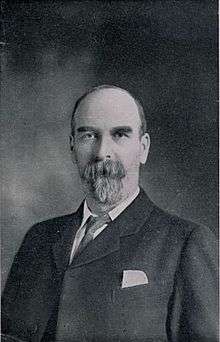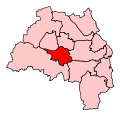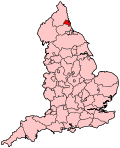Gateshead (UK Parliament constituency)
| Gateshead | |
|---|---|
|
Borough constituency for the House of Commons | |
|
Boundary of Gateshead in Tyne and Wear for the 2010 general election. | |
|
Location of Tyne and Wear within England. | |
| County | Tyne and Wear |
| Electorate | 66,066 (December 2010)[1] |
| Major settlements | Gateshead |
| Current constituency | |
| Created | 2010 |
| Member of parliament | Ian Mearns (Labour) |
| Number of members | One |
| Created from | Gateshead East & Washington West, and Tyne Bridge |
| 1832–1950 | |
| Number of members | One |
| Type of constituency | Borough constituency |
| Created from | County Durham |
| Overlaps | |
| European Parliament constituency | North East England |
Gateshead is a constituency[n 1] represented in the House of Commons of the UK Parliament since its 2010 recreation by Ian Mearns of the Labour Party.[n 2]
History
The previous incarnation of the seat existed from 1832 to 1950. Among famous representatives are James Melville KC who was Solicitor General for England and Wales before he died, while holding the seat, and international statesman Konni Zilliacus who assisted in creating peaceful bilateral relations during the Cold War, including though work at the United Nations.
Boundaries
2010–present: The Metropolitan Borough of Gateshead wards of Bridges, Chowdene, Deckham, Dunston and Teams, Felling, High Fell, Lobley Hill and Bensham, Low Fell, Saltwell, and Windy Nook and Whitehills.
The Boundary Commission's 2007-8 review led to a revived constituency of Gateshead, using parts of the abolished Gateshead East and Washington West and Tyne Bridge seats.
Members of Parliament
MPs 1832–1950
| Election | Member[2] | Party | |
|---|---|---|---|
| 1832 | Cuthbert Rippon | Whig | |
| 1841 | (Sir) William Hutt | Whig | |
| 1859 | Liberal | ||
| 1874 | Walter Henry James | Liberal | |
| 1893 | Sir William Allan | Liberal | |
| 1904 | John Johnson | Liberal | |
| 1910 | Sir Harold Elverston | Liberal | |
| 1918 | Herbert Conyers Surtees | Coalition Conservative | |
| 1922 | John Brotherton | Labour | |
| 1923 | John Purcell Dickie | Liberal | |
| 1924 | John Warburton Beckett | Labour | |
| 1929 | Sir James Benjamin Melville | Labour | |
| 1931 | Herbert Evans | Labour | |
| 1931 | Thomas Magnay | National Liberal | |
| 1945 | Konni Zilliacus | Labour (1945–49) Labour Independent Group (1949) Independent Labour (1949–50) | |
| 1950 | constituency abolished | ||
MPs since 2010
| Election | Member[2] | Party | |
|---|---|---|---|
| 2010 | Ian Mearns | Labour | |
Elections
The re-established Gateshead constituency was fought for the first time at the 2010 general election. Tyne Bridge MP David Clelland was chosen as the Labour Party candidate for the seat in 2008, but later stood down. The seat was instead contested and won by Gateshead Councillor Ian Mearns.
Elections in the 2010s
| Party | Candidate | Votes | % | ± | |
|---|---|---|---|---|---|
| Labour | Ian Mearns | 21,549 | 56.8 | +2.6 | |
| UKIP | John Tennant | 6,765 | 17.8 | +14.9 | |
| Conservative | Thomas Smith | 5,502 | 14.5 | −0.4 | |
| Liberal Democrat | Frank Hindle | 2,585 | 6.8 | −14.5 | |
| Green | Andy Redfern[4] | 1,548 | 4.1 | +3.1 | |
| Majority | 14,784 | 39.0 | +6.2 | ||
| Turnout | 40,451 | 59.4 | +1.9 | ||
| Labour hold | Swing | ||||
| Party | Candidate | Votes | % | ± | |
|---|---|---|---|---|---|
| Labour | Ian Mearns | 20,712 | 54.1 | −7.3 | |
| Liberal Democrat | Frank Hindle | 8,163 | 21.3 | +0.6 | |
| Conservative | Hazel Anderson | 5,716 | 14.9 | +4.8 | |
| BNP | Kevin Scott | 1,787 | 4.7 | +1.6 | |
| UKIP | John Tennant | 1,103 | 2.9 | −0.4 | |
| Green | Andy Redfern | 379 | 1.0 | +1.0 | |
| TUSC | Elaine Brunskill | 266 | 0.7 | +0.7 | |
| Christian | David Walton | 131 | 0.3 | +0.3 | |
| Majority | 12,549 | 32.8 | |||
| Turnout | 38,257 | 57.5 | +3.8 | ||
| Labour hold | Swing | ||||
Elections in the 1940s
| Party | Candidate | Votes | % | ± | |
|---|---|---|---|---|---|
| Labour | Konni Zilliacus | 36,736 | 67.5 | ||
| Liberal National | Thomas Magnay | 17,719 | 32.5 | ||
| Majority | 19,017 | 34.9 | |||
| Turnout | 54,455 | 76.0 | |||
| Labour gain from Liberal National | Swing | ||||
Elections in the 1930s
| Party | Candidate | Votes | % | ± | |
|---|---|---|---|---|---|
| Liberal National | Thomas Magnay | 28,772 | 52.72 | ||
| Labour | J. Wilson | 25,804 | 47.28 | ||
| Majority | 2,968 | 5.44 | |||
| Turnout | 74.68 | ||||
| Liberal National hold | Swing | ||||
| Party | Candidate | Votes | % | ± | |
|---|---|---|---|---|---|
| Liberal National | Thomas Magnay | 34,764 | 60.09 | ||
| Labour | Ernest Bevin | 21,826 | 37.73 | ||
| New Party | John Stuart Barr | 1,077 | 1.86 | ||
| National Labour | John Fennell | 187 | 0.32 | ||
| Majority | 12,938 | 22.36 | |||
| Turnout | 78.32 | ||||
| Liberal National gain from Labour | Swing | ||||
Conservative candidate Charles White withdrew 15 October 1931. Barr and Fennell also withdrew, but their names remained on the ballot paper.
| Party | Candidate | Votes | % | ± | |
|---|---|---|---|---|---|
| Labour | Herbert Evans | 22,893 | 51.6 | −1.0 | |
| Conservative | Cuthbert Headlam | 21,501 | 48.4 | +26.9 | |
| Majority | 1,392 | 3.2 | −27.9 | ||
| Turnout | 44,394 | 60.8 | −13.1 | ||
| Labour hold | Swing | ||||
Elections in the 1920s
| Party | Candidate | Votes | % | ± | |
|---|---|---|---|---|---|
| Labour | Sir James Benjamin Melville | 28,393 | 52.6 | +2.4 | |
| Unionist | Ian Leslie Orr-Ewing | 11,644 | 21.5 | -8.7 | |
| Liberal | John Fennell | 10,314 | 19.1 | -0.5 | |
| Independent Liberal | John Leonard Watson | 3,688 | 6.8 | n/a | |
| Majority | 16,749 | 31.1 | +11.1 | ||
| Turnout | 73.9 | -8.8 | |||
| Labour hold | Swing | +5.5 | |||
| Party | Candidate | Votes | % | ± | |
|---|---|---|---|---|---|
| Labour | John Warburton Beckett | 23,514 | 50.2 | +9.1 | |
| Unionist | Hilton Philipson | 14,178 | 30.2 | +14.0 | |
| Liberal | John Purcell Dickie | 9,185 | 19.6 | -23.1 | |
| Majority | 9,336 | 20.0 | 21.6 | ||
| Turnout | 82.7 | +9.5 | |||
| Labour gain from Liberal | Swing | -2.5 | |||
| Party | Candidate | Votes | % | ± | |
|---|---|---|---|---|---|
| Liberal | John Purcell Dickie | 17,344 | 42.7 | +17.8 | |
| Labour | John Brotherton | 16,689 | 41.1 | -2.7 | |
| Unionist | George Francis Stephen Christie | 6,592 | 16.2 | -15.1 | |
| Majority | 355 | 1.6 | 20.5 | ||
| Turnout | 73.2 | -5.2 | |||
| Liberal gain from Labour | Swing | +10.3 | |||
| Party | Candidate | Votes | % | ± | |
|---|---|---|---|---|---|
| Labour | John Brotherton | 18,795 | 43.8 | +20.0 | |
| Unionist | Herbert Conyers Surtees | 13,424 | 31.3 | -25.6 | |
| Liberal | John Purcell Dickie | 10,679 | 24.9 | +5.6 | |
| Majority | 5,371 | 12.5 | 45.6 | ||
| Turnout | 78.4 | +23.8 | |||
| Labour gain from Unionist | Swing | +22.8 | |||
Elections in the 1910s
| Party | Candidate | Votes | % | ± | |
|---|---|---|---|---|---|
| Unionist |
|
17,215 | 56.9 | +17.9 | |
| Labour | John Brotherton | 7,212 | 23.8 | +23.8 | |
| Liberal | Sir Harold Elverston | 5,833 | 19.3 | -41.7 | |
| Majority | 10,003 | 33.1 | |||
| Turnout | 54.6 | ||||
| Unionist gain from Liberal | Swing | ||||
- endorsed by Coalition Government
| Party | Candidate | Votes | % | ± | |
|---|---|---|---|---|---|
| Liberal | Harold Elverston | 8,763 | 61.0 | +20.3 | |
| Conservative | Herbert Conyers Surtees | 5,608 | 39.0 | +1.1 | |
| Majority | 3,155 | 22.0 | +19.2 | ||
| Turnout | 75.1 | ||||
| Liberal hold | Swing | ||||

| Party | Candidate | Votes | % | ± | |
|---|---|---|---|---|---|
| Liberal | Harold Elverston | 6,800 | 40.7 | +40.7 | |
| Liberal Unionist | Nicholas Grattan-Doyle | 6,323 | 37.9 | +3.2 | |
| Labour | John Johnson | 3,572 | 21.4 | -43.9 | |
| Majority | 477 | 2.8 | |||
| Turnout | 87.2 | +7.8 | |||
| Liberal gain from Labour | Swing | +42.3 | |||
Elections in the 1900s
| Party | Candidate | Votes | % | ± | |
|---|---|---|---|---|---|
| Lib-Lab | John Johnson | 9,651 | 65.3 | ||
| Liberal Unionist | Sir Theodore Vivian Samuel Angier | 5,126 | 34.7 | ||
| Majority | 4,525 | 30.6 | |||
| Turnout | 79.4 | ||||
| Lib-Lab hold | Swing | ||||
See also
Notes and references
- Notes
- ↑ A borough constituency (for the purposes of election expenses and type of returning officer)
- ↑ As with all current constituencies, the constituency elects one Member of Parliament (MP) by the first past the post system of election at least every five years.
- References
Craig, F. W. S. (1983). British parliamentary election results 1918-1949 (3 ed.). Chichester: Parliamentary Research Services. ISBN 0-900178-06-X.
- ↑ "Electorate Figures - Boundary Commission for England". 2011 Electorate Figures. Boundary Commission for England. 4 March 2011. Retrieved 13 March 2011.
- 1 2 Leigh Rayment's Historical List of MPs – Constituencies beginning with "G" (part 1)
- ↑ "Election Data 2015". Electoral Calculus. Archived from the original on 17 October 2015. Retrieved 17 October 2015.
- ↑ http://www.thenorthernecho.co.uk/news/11728362.Greens_name_election_candidates/
- ↑ "Election Data 2010". Electoral Calculus. Archived from the original on 26 July 2013. Retrieved 17 October 2015.
- ↑ Official results from Gateshead Council
Sources
- Craig, F. W. S. (1983) [1969]. British parliamentary election results 1918-1949 (3rd ed.). Chichester: Parliamentary Research Services. ISBN 0-900178-06-X.

